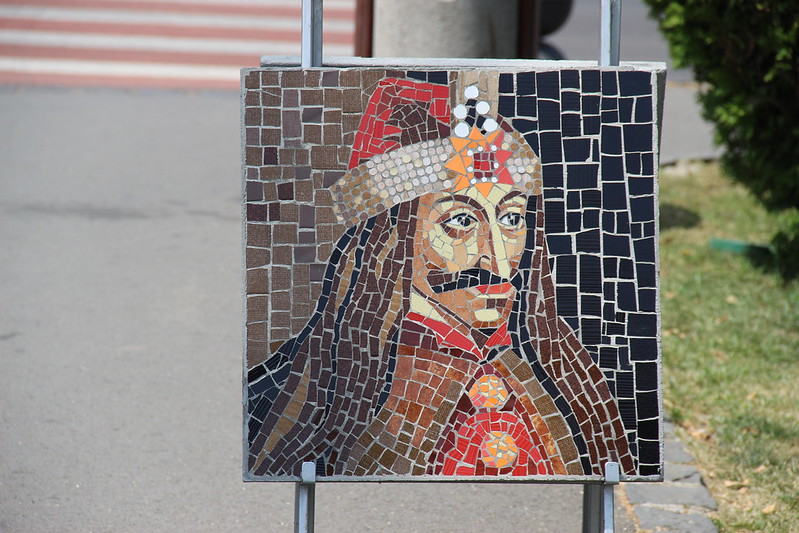When Bram Stoker created Dracula in 1897, he drew from many sources. Perhaps the most disturbing of those was the life of a man who has become known as the ‘real’ Dracula, or at least the inspiration – Vlad III, the Prince of Wallachia. Also known as Vlad the Impaler.
Wallachia is an Eastern European country which achieved independence from Hungary in the early 14th century. In 1859 they joined with Moldavia to become what is now known as Romania. In between they had many rulers, including one man whose unspeakable cruelty lives on in horror stories to this day. Today, the region of Romania where Vlad III lived is known as Transylvania.

Vlad II Dracul ruled the region in 1431. His father was an illegitimate son of the previous ruler. Vlad II rose to power, lost it, and recaptured his rule during his lifetime. He was raised in the court of the Ottoman Empire, where he was a member of the Order of The Dragon. Dragon in Romanian is “Dracul”, which is where Dracula comes from. Vlad the third’s father was the source of a fearsome lineage for a frightening young son to take up.

Vlad’s Gruesome Reputation
Vlad Tepes was actually the second son of his father, but both his father and eldest brother were killed in dynastic struggles. He became ruler of Wallachia in 1448, when he was only seventeen years old. During his lifetime, Vlad III Dracul would ascend to the throne of Wallachia three times. This Romanian ‘game of thrones’ often involved fighting bitterly. Regaining his title often left a trail of bodies.
Today, he is known as a Romanian folk hero and a defender of the Christian Faith against Islamic invaders. Vlad III was also a member of his father’s order, the Order of The Dragon. As such, he adopted the surname Dracul – leading to the modern sobriquet Dracula. But how did this ruler, who couldn’t even hang on to his throne and spent two periods in exile or prison after first taking power, become the inspiration for the famous, gruesome Dracula?

His reputation was partially shaped by a poem about two monks he took captive. In the poem, titled Von ainem wutrich der heis Trakle waida von der Walachei (Story of a Bloodthirsty Madman Called Dracula of Wallachia), meistersinger Michael Beheim makes some pretty bold claims about the Blood Drinking Prince of Darkness. Beheim graphically described how Vlad took some innocent monks prisoner. Vladdie felt the monks had betrayed Christian forces to their Muslim opponents and impaled those monks and left them to die. When asked why he put them on top of 6 foot tall wooden spikes, he claimed that he did so to help them reach Heaven. When their donkey began to bleat, Vlad impaled it, too.
The poem may not be a complete fabrication. Stories of the brutal, bloody villainy of raids led by Vlad the third were widespread among the Saxons. Vlad III used impalement to break the power of the Boyars (noblemen) of Wallachia. Eye-witness accounts described how he destroyed churches, boiled people alive, and murdered indiscriminately – not just soldiers but mothers and babies too. He was said to enjoy eating at a table surrounded by his impaled victims.

The printing press made Vlad a household name
Vlad the Impaler was hardly the first bloodthirsty, cruel conqueror. Yes, he has been described as worse than even Nero or Caligula, but how did this man from this small Transylvanian throne become so famous? The answer lies in the new movable type printing presses of the era. Whether as entertainment, propaganda, or historical record, stories of Vlad’s murderous conquests were widely printed and sold. From there, they became popular stories. His tales were some of the first bestsellers, preferred by the earliest fans of true crime. Bram Stoker’s knowledge of the horrible man comes from these records, as does ours.
How much of the horror told of Vlad’s conquests was true, and how much was fiction? We may never know. There will always be speculation about men in power, about murderous monsters, and about tyrants. Vlad Tepes uniquely captured the imaginations of the public with his storied history of cruelty. Today we continue retelling his stories and those based on him, bloody and brutal and uniquely fascinating.


One response to “Vlad the Impaler and Vampires”
[…] Hailey’s vampire slaying kit included a Gothic bible, stake (and hammer), holy water, crucifix, rosary, and, oddly enough, pistols with bronze powder flask. Perhaps the […]